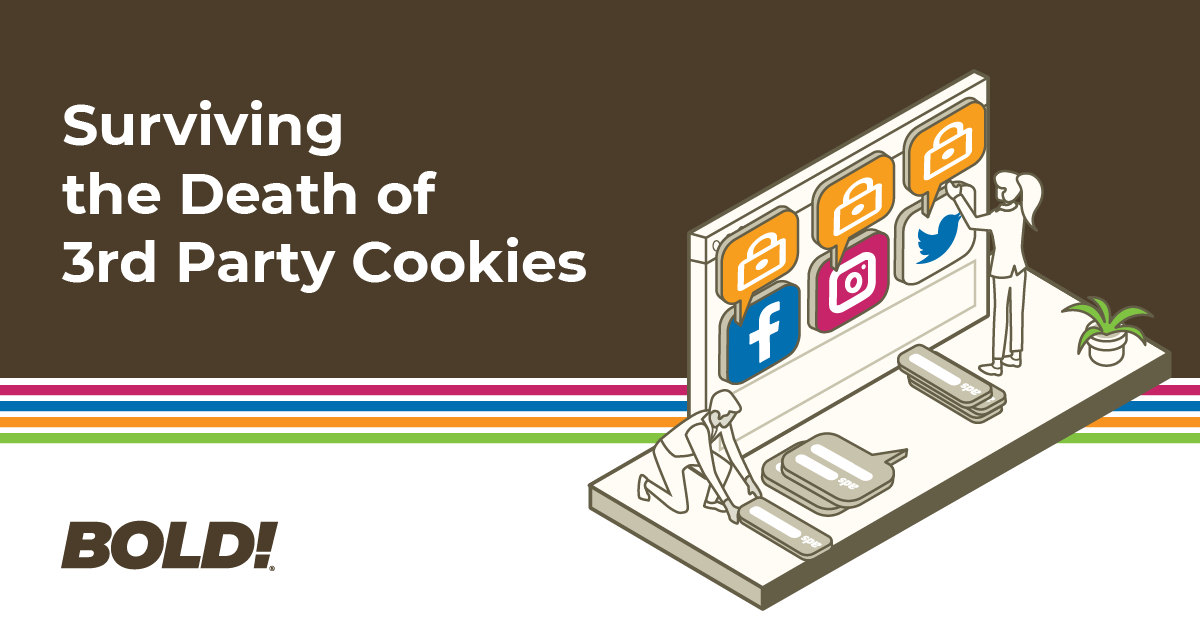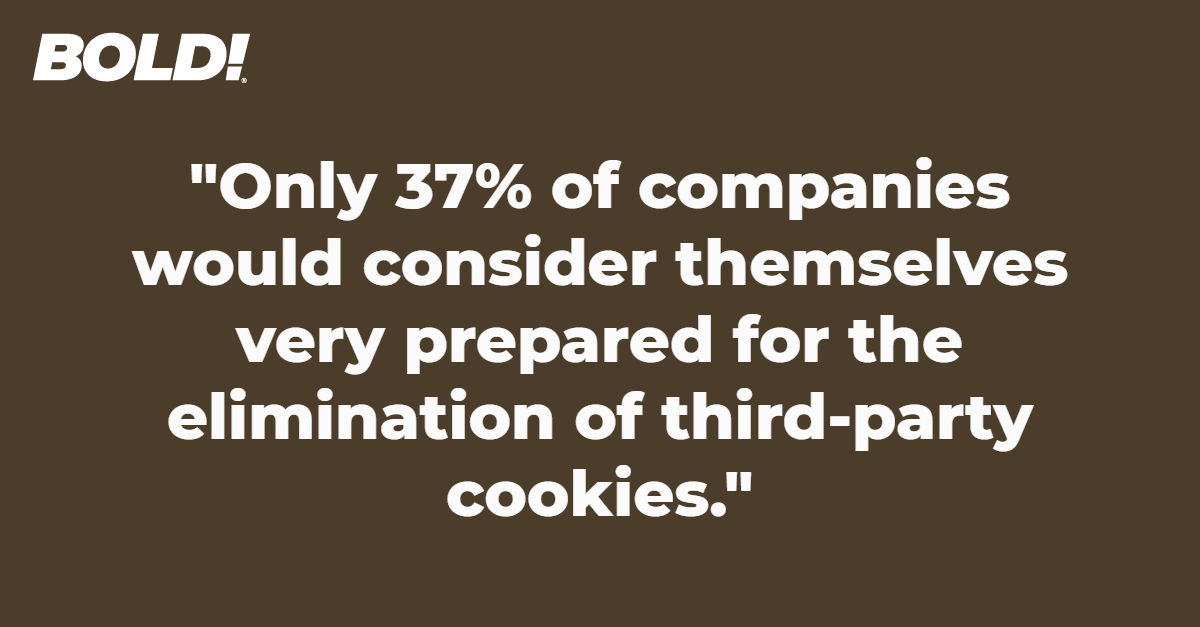How eCommerce Marketers can Survive the Death of 3P Cookies
August 26, 2021

By this point you’ve probably heard that third-party cookies will soon be no more. Whether you know what that means or this is the first time you’re searching for solutions, you’ve come to the right place. It’s time to start taking action to prepare your eCommerce business for the elimination of the third-party cookie.
What’s the difference between first and third-party cookies?
Let’s take a step back. Before we continue it’s important to clarify exactly what is staying, what’s going, and why they matter.
First-party cookies are created by the website a user is visiting. They aid in user experience by remembering login information, items in their cart, language preferences, etc. All browsers support first-party cookies and give users the ability to block and delete them.
Third-party cookies are created and installed by, you guessed it, a third party. This third party is typically an advertiser (Facebook for example) that creates code that can be installed on the website being visited. Third-party cookies are used to gather cross-site behavior, allow for retargeting, serve ads, and more. Users have always been able to block and delete these, but many browsers are now blocking their creation automatically as a way to protect privacy.
So, what’s going on with cookie elimination anyway?
A lot of the talk is about the “cookieless future,” but that statement is actually incorrect. It’s just third-party cookies that won’t be around much longer, first-party cookies aren’t going anywhere.
Most web browsers are (or already have) phasing out third-party cookies. Browsers like Safari and Firefox eliminated third-party cookies over the past two years. Google Chrome is the big, key player that will phase them out in late 2023.
So why is it a big deal all of the sudden? Google Chrome accounts for over 60% of the internet browser global market share. The next competitor, Safari, greatly trails the browser giant at 19%. That being said, it’s no surprise that the market leader eliminating third-party cookies is making a big splash.

How privacy-centered changes are already impacting eCommerce retailers
Marketers have already gotten a glimpse of the repercussions of a more privacy-centered online space with Apple’s iOS 14.5 data privacy settings. Apple now requires apps and advertisers to request permission to track mobile device IDs. When users opt-out, it prohibits apps and advertisers like Facebook from tracking cross-app/site behavioral data. Within the first 3 weeks of the iOS 14.5 launch, only around 6% of US users opted-in to tracking. Those numbers have improved some since then but iOS 14.5 and other upcoming changes are dealing a huge blow to the digital advertising industry.
Since advertisers are no longer able to gather data on how their users are behaving online if they opt-out, audience segmentation and behavioral targeting down to an individual level is no longer possible on the scale it once was.
This opt-out effect is a precursor to the elimination of third-party cookies online. A lot of audience targeting, ad personalization, and ad tracking for advertising platforms is based on data from third-party cookies.
So, what happens now? Only 37% of companies would consider themselves very prepared for the elimination of third-party cookies. We don’t want you to be in that 63% majority who don’t feel prepared for this change. That’s why we put together some practical tips.
Strategies for eCommerce retailers and third-party cookie elimination
1. Gather as much first-party data as your shoppers want to share
Your brand website, or better yet, DTC store is where most of your data will originate. Email, phone number, demographic, and interest data are just a few examples of the first-party data you should start collecting ASAP. This is information your users are handing to you and opting themselves in for you to use. You can utilize all of this data to launch hyper-targeted email and SMS marketing campaigns. This gives users a highly personalized experience across the whole customer journey, without breaching their trust and privacy. When done properly and respectfully, both the brand and the shopper win!
2. Consider shifting ad dollars to Retail Media
Unlike traditional media, Retail Media is not impacted by changes outlined here. In fact, Retailers are getting better every day at using their own first party data to customize experiences and offers for their shoppers. Brands can now find the right shopper to message based on retail browsing and buying behavior. All of this is available in major offerings like Walmart Connect, Amazon DSP, and Kroger Performance Media. You can read more about it in BOLD’s “Demystifying Retail Media.”
3. Capitalize on owned media
Owned media is any online channel that a brand is able to control. It includes properties such as your website, blog, social media posts, ebooks, content, etc. It’s important to utilize owned media to organically build your brand, resulting in trust and loyalty from users. You need to communicate the value of your brand and products and the problems that they solve for the user. If the user trusts you without purchasing your product, they are more likely to choose you when they are ready to buy.
4. Improve your customer experience
Figure out any gaps in your customer experience and work hard to improve them. How can you…
- Improve website experience? Is it fast enough? Is the UX truly great?
- Test creative in email and paid media to best fit your audience?
- Utilize dynamic content to personalize your experience on landing pages, emails, and SMS
Simple improvements in your existing (or new) marketing processes can make a huge difference.
5. Transition to Google Analytics 4 for data tracking
Create a new Google Analyics property using Google Analytics 4 (GA4) to quickly start gathering data in their new platform. It’s the new default property type, so if you don’t adopt it soon you’ll lag behind. Google introduced GA4 to help accommodate the cookie changes. The data is event-driven rather than session-driven, which helps marketers analyze the data according to KPIs. Instead of cookies, event information will be used to create audiences.

What to expect in the future - strategies and predictions
Google is already developing more robust capabilities for targeting based on interest groups rather than individual users. Google’s Federated Learning of Cohorts (FLoC) is an API within Chrome that will create “cohorts” of users that share interests. The individual’s identity and browsing history will not be disclosed, creating a private and more anonymous experience.
FLoC is part of Google’s Privacy Sandbox initiative dedicated to “building a more private, open web.” The Privacy Sandbox proposes more than just the elimination of third-party cookies to protect users' privacy. They are also developing solutions to fight spam and fraud, tailor content and ads, and anonymize ad reporting.
Google has also already announced Android’s new privacy settings in response to Apple’s iOS 14.5. They will give users access to a “Privacy Dashboard” and clearer tracking opt-out abilities.
The privacy-centered future is still bright, just different
Google doing away with third-party cookies doesn’t mean that all data and hope is lost. Brands will still know that their advertising is effective, they just won’t know who individually is taking action.
Don’t let the upcoming changes halt growth for your eCommerce brand. Start taking action now to innovate your online presence and adjust to be more privacy-centered.
Unsure where to begin? Schedule a Strategy Session with our Solutions team to get started!
